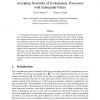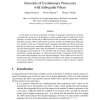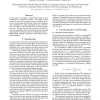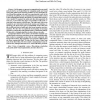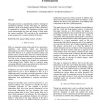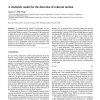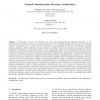AFL
2011
13 years 4 months ago
2011
In this paper, we propose a new variant of Accepting Networks of Evolutionary Processors, in which the operations can be applied only arbitrarily to the words, while the filters ...
LATA
2011
Springer
13 years 7 months ago
2011
Springer
In this paper we propose a hierarchy of classes of languages, generated by networks of evolutionary processors with the filters in several special classes of regular sets. More p...
INTERSPEECH
2010
13 years 11 months ago
2010
In this paper we investigate a computational model of word learning that is cognitively plausible. The model is partly trained on incorrect form-referent pairings, modelling the i...
IJCV
2007
14 years 4 months ago
2007
Robots often incorporate computational models of visual attention to streamline processing. Even though the number of visual attention systems employed on robots has increased dram...
TMM
2002
14 years 4 months ago
2002
In this paper, we present a computational scene model and also derive novel algorithms for computing audio and visual scenes and within-scene structures in films. We use constraint...
TITB
2002
14 years 4 months ago
2002
This paper presents a computational model for studying the mechanical properties of skin with aging. In particular, attention is given to the folding capacity of skin, which may b...
NN
2002
Springer
14 years 4 months ago
2002
Springer
In this paper we implement a computational model of a neuromodulatory system in an autonomous robot. The output of the neuromodulatory system acts as a value signal, modulating wi...
BC
2004
14 years 4 months ago
2004
A computational model is presented for the detection of coherent motion based on template matching and hidden Markov models. The premise of this approach is that the growth in dete...
ET
2007
14 years 4 months ago
2007
In this paper, we focus on reliability, one of the most fundamental and important challenges, in the nanoelectronics environment. For a processor architecture based on the unreliab...
LOGCOM
2008
14 years 4 months ago
2008
We investigate mathematical modelling with theories of data types. We provide a formal setting for the formulation of such theories (TPL) and use it to introduce the notion of a c...
